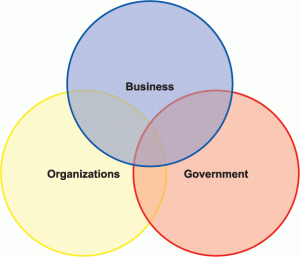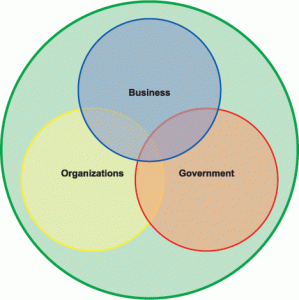Terms like Corporate Social Responsibility (CSR) can be quite misleading in their current ‘trend’ of up and coming business practices. Everyone was buzzing about whose CSR reports were more detailed and in-depth than others. Others invested in more bleeding heart initiatives, like building wells in Africa (they rarely mention how that community came to be without water in the first place). This first wave of CSR was mainly pushed by image, as at the time consumer awareness wasn’t high enough to greatly influence demand. However, now that the consumer is getting more empowered, thanks mainly to a wave of whistler blowers and watchdog accountability organizations, the tables are turning and demand is changing. Even controversial lobby groups like tobacco, alcohol and firearms industries are finding it hard to penetrate the growing awareness.
So what then is CSR today and what role does my company need to engage with it?
The question posed is a self-fulfilling hoax if we are to believe that CSR is something that must be ‘engaged’ or ‘invested into’. The truth of the matter is that CSR is a philosophy of doing business, a very smart philosophy. I like to think of CSR as an ecosystem. Within this ecosystem we have many different actors exchanging goods and services with others. So how is this different than an actual economic market?
To answer this, let’s look at the bigger picture. To do that, we need to go back to the basics of who these actors are and what are their roles.
To begin, let’s loosely categorize all the actors into three groups. These groups are: Government, Business and Organizations (non-governmental organizations, union lobbyists, hobby circles or even family entities can fall under this category).
These categories were decided based on looking at the nature of the roles they performed:
- Companies are organizations of people coming together to make a product or service.
- Organizations are people coming together to provide solutions to the needs of individuals and communities.
- Governments are organizations of people coming together to help organize society and maintain order.
Therefore what defines these actors is merely the role they play within this ecosystem. Now since an ecosystem is a self-contained system (also called closed loop), we need to look at what binds all these actors together. What I found is that one of the main things that tie these groups together is actually the compe-tition for shared resources that they use within this ecosystem. So let’s add this into the model and you get something like this:
Competition for Resources?
Are governments, companies and organizations in competition with one another? Of course! Due to the finite nature of our ecosystem all these actors need access to the same or similar resources as one another for either their livelihood, or even for basic survival.
True Cost of Resources
Currently, our economic system is set up in a way that it attaches arbitrary values to things based mainly on the cost of acquiring the resources, and the given market value of the demand for those resources. The term, externalities refers to invisible costs that are not related to the acquisition of resources or related to market demand. Here is another term that can be misleading, since we live on one planet, in constant competition for resources, therefore, realistically, nothing should be considered ‘external’.
Let’s say you are in the water bottling industry, and you survey a fresh water source, and calculate the total potential output of that water source until depletion. The moment that depletion occurs, even in 50-100 years you must realize that that resource is no longer available. So now you have to go look for new sources of fresh water to use. The same examples can be found in all primary and secondary industries (by the time you get to tertiary or quaternary industry, you sometimes tend to forget or not care where the raw material came from, or how it got to you, rather only that you got the best deal for your money).
This is the point of weakness in our economic-driven society. We do not take into account the full array of externalities involved – the true cost of depleting that fresh water source. Nor do we factor the impact and loss of wildlife, or communities downstream who depend on that water source for their basic needs, or the farmers who require that water source to grow a product your business may come to need. These are all part of the ecosystem that will return and have an impact on you.
So how do we evaluate true cost and what does it have to do with CSR and collaboration?
Collaboration: Identifying True Costs of Business
The truth is that there is no economic equation that can evaluate the true cost of any of our actions. So how do we go about evalua-ting the true cost of our actions?
If you guessed collaborations, then give yourself a pat on the back for paying attention and connecting the dots.
Yes, environmentally, people may be the worst thing that happened to the planet, but it is also the best thing that ever happened. That is because we have an incredible ability to identify with our surroundings and understand implications, both negative and positive to our situations.
Quality of life is another term that is subject to scrutiny along today’s trends. Contrary to traditional belief, and supported by nume-rous research, material acquisition of products does not enhance our quality of life; rather it is ensuring our safety and that our needs are met, and we are in positive contributing relationships with our communities.
Let’s say you are out to survey a new area to gather or extract resources. Chances are that you are going to find your best soluation of true costs (those externalized hidden numbers) by collaborating with surrounding communities that might be affected by your interests. Through collaborative studies, you will determine the true implications of your actions. A good design plan will provide solutions for negative impli-cations before the project begins. However, as we are in evolving times, ollaboration must be an ongoing relationship, as unforeseen circumstances can change a positive implication into a negative one, and vice versa. The opportunity for your company to stay on top in their industry is the ability to evaluate these impacts on an ongoing basis and make the necessary changes to the strategy in order to create more positive implication scenarios.
Benefits of Positive Implications
We are still talking externalities here, but these lessons can also be applied to you personally, to your family or the community in which you live. As what is true for when we do something nice for someone else, is also true for how we do business. When you enhance someone’s way of life and happiness, the more likely it is that they will repay you, sometimes immediately and sometimes later on, but it does return in many ways. It also helps with forecasting, as instead of getting hit by market shocks or unforeseen events, you are more likely to be hit with pleasant surprises which can enhance your way of doing business.
Henry Ford knew this, and that is why when he launched the model-T. He envisioned enhancing the lives of his workers to the point where they too could afford to buy his products. So if you are a water bottling company, who wouldn’t want an impact assessment to return to the boss saying that thanks to community interaction and involvement with the ecosystem, we will have access to an unlimited supply of fresh water, for as long as we want to be in business. Now that makes good business sense.







